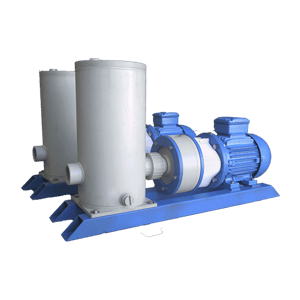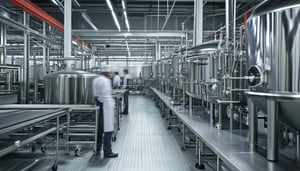The entire range of mechanically sealed and magnetically driven Crest chemical pumps can be fitted with a priming chamber capable for suction lifts of up to 4.5 meters.
The priming chamber is machined and fabricated from the same chemical resistant materials as the pump body; ensuring total corrosion resistance against the harsh chemical applications for robust and rugged construction.
Priming chambers offer a simple and reliable method of converting conventional end suction pumps for self-priming applications.

How does a priming chamber work?
A priming chamber works by ensuring that a pump is filled with liquid before it starts operating. In many pumps, especially centrifugal pumps, air can be trapped in the system, which prevents the pump from creating the necessary suction to draw in fluid. The priming chamber solves this problem by filling with liquid and removing air from the pump casing.
Here’s how it works:
Filling the Chamber: When the pump starts, the priming chamber allows liquid to flow into the pump casing, filling it and pushing out any air.
Creating Suction: The chamber ensures that the pump has a full column of liquid to create the suction needed to move the fluid through the system.
Maintaining the Prime: Once the pump is primed, the chamber ensures a continuous flow, preventing air from entering the system.
Priming chambers are commonly used in pumps where suction needs to be established manually, such as in self-priming pumps or when handling viscous or air-sensitive fluids. They are crucial for ensuring the pump starts efficiently and avoids dry running or damage.

THE CREST PUMPS LIFETIME GUARANTEE
No matter how old your pump becomes, in the unlikely scenario that you have a problem, our engineers will be on hand to diagnose the issue and help you get up and running again.That’s why, with Crest Pumps you’ll never need to worry about unplanned downtime again.
Talk to us now to discuss your chemical pump requirements or book a free site audit to see how much time and money you could save!
Built to outlast and outperform
Discover the significant savings you can achieve and explore the potential financial benefits that await you.

Frequently Asked Questions
Best Efficiency Point (BEP) is the operating point at which a pump runs at its highest efficiency while minimizing energy consumption and wear. It
represents the optimal balance between flow rate and head, ensuring the pump delivers the best performance with the least amount of stress on its components.
Operating a pump away from its BEP—either too far to the left (low flow, high head) or too far to the right (high flow, low head)—can lead to problems such as cavitation, excessive vibration, increased energy costs, and premature wear on bearings and seals. Proper pump selection and system design aim to keep the pump as close to its BEP as possible to maximize efficiency, reduce maintenance costs, and extend pump life.
Lifecycle Cost (LCC) Analysis is a method used to determine the total cost of ownership of a pump over its entire operational lifespan. Instead of focusing solely on the initial purchase price, LCC considers all costs associated with the pump, including installation, energy consumption, maintenance, repairs, downtime, and disposal or replacement. By evaluating these factors, businesses can make informed decisions that minimize overall expenses and improve efficiency.
For pumps, energy costs typically make up the largest portion of LCC, often exceeding the initial purchase price. Other significant factors include maintenance and repair costs, which can increase if a pump operates outside its Best Efficiency Point (BEP) or is not properly maintained. By selecting energy-efficient models, implementing predictive maintenance, and considering materials that extend pump life, businesses can reduce LCC and achieve long-term cost savings while improving reliability and performance.
-
NPSHa stands for Nett Positive Suction AVAILABLE and NPSHr stands for Nett Positive Suction Head REQUIRED.
Now, what is the difference between NPSHa and NPSHr? Well, firstly NPSH is a measure of the pressure experienced by the fluid at the suction of the pump. This is always quoted in metres (or feet) rather than as a pressure because head is a fluid independent property. Keep in mind that a pump will always lift liquid to the same height regardless of the fluid's respective densities.
NPSHa (available) is a property of the system and is calculated by the system designer giving a value of the pressure on the suction side of the pump.
NPSHr (required) is a property of the pump. This is calculated by the manufacturer as the point where cavitation occurs. It is good practice to have a safety margin between 0.5m and 1m.
The SI system (International System, or System International in French) is the standard system of measurement used globally for scientific, industrial, and everyday purposes. It is based on the metric system and provides a consistent and coherent set of units for measuring various physical quantities such as length, mass, time, temperature, and more.
The SI system is built on seven base units, each representing a fundamental physical quantity. These base units are:
Meter (m) for measuring length
Kilogram (kg) for measuring mass
Second (s) for measuring time
Ampere (A) for measuring electric current
Kelvin (K) for measuring the temperature of a substance
Candela (cd) for measuring luminous intensity.
Trusted By The Best





































